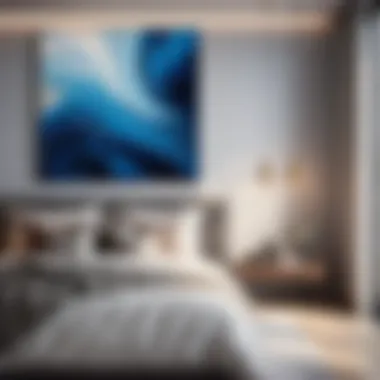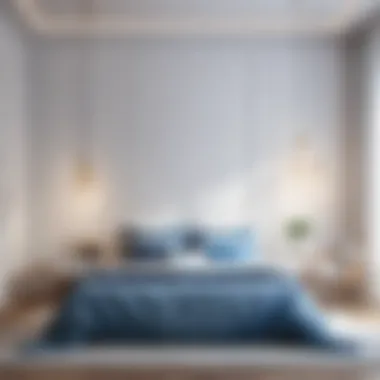Discover the Finest Blues for a Tranquil Bedroom Escape


Materials:
- Paint in various shades of blue: 2 gallons of light blue, 1 gallon of medium blue, 1 gallon of navy blue
- Paintbrushes: 1 large brush for covering large areas, 1 small brush for trimming edges
- Painter's tape: to protect surfaces from accidental paint
- Drop cloths: to cover and protect floors and furniture
- Primer: to ensure proper adhesion and coverage of the paint
- Roller trays and liners: for easy paint application
- Stir sticks: to mix paint thoroughly before application
DIY Steps:
- Prepare the Room: Clear out the bedroom, remove furniture, and cover floors and any remaining items with drop cloths.
- Select Paint Colors: Choose the light blue as the base color for the walls, with medium blue for an accent wall, and navy blue for furniture or decorative elements.
- Prime the Walls: Apply primer to the walls to ensure an even base for the paint colors.
- Start Painting: Begin with the light blue paint on the walls, moving methodically and evenly. Use the large brush for broad strokes and the small brush for corners and edges.
- Accent Wall: Paint the chosen wall with medium blue, creating a focal point in the room.
- Furniture Painting: Use the navy blue to paint any furniture pieces or decorative items for cohesion.
- Final Touches: Allow the paint to dry completely before moving furniture back into the room.
Technical Aspects:
- Tools: Paintbrushes, painter's tape, drop cloths, roller trays, stir sticks
- Timing: Allow ample time for each coat of paint to dry before applying the next layer.
- Techniques: Use long, even strokes for a smooth finish; remove painter's tape carefully to prevent peeling.
DIY Project Process:
- Planning Stage: Determine the color scheme and the placement of different shades of blue in the room.
- Execution: Follow the step-by-step painting process, ensuring each coat is applied evenly and allowed to dry properly.
- Finishing Touches: Once the painting is complete, assess the room for any touch-ups needed and make adjustments as necessary.
Troubleshooting Tips:
- If paint drips occur, gently sand the area and reapply paint for a seamless finish.
- In case of color differences, ensure proper mixing of paint and consistent application techniques for uniformity.
Introduction
Blues for a bedroom are not merely a choice of color; they hold the power to transform a space into a sanctuary of tranquility and beauty. This comprehensive guide will delve into the nuances of selecting the perfect shades of blue to enhance the mood and atmosphere of your bedroom. By understanding the significance of bedroom colors and the specific impact blue has on creating a calming ambiance, readers will gain valuable insights into elevating their living space.
Significance of Bedroom Colors
The colors we surround ourselves with in our bedrooms play a crucial role in shaping our overall well-being. From influencing our emotions to affecting our quality of sleep, bedroom colors transcend mere aesthetics. Specifically, the choice of blues can evoke feelings of serenity, peace, and relaxation. Understanding the significance of bedroom colors, especially the calming effects of blue tones, is essential in curating a space that promotes rest and rejuvenation.
Impact of Blue on Mood and Atmosphere
Blue, known for its soothing properties, has a profound impact on the mood and atmosphere of a room. This color is synonymous with peace and tranquility, making it an ideal choice for creating a calming sanctuary in a bedroom. Lighter blues evoke a sense of airiness and spaciousness, perfect for promoting relaxation and unwinding after a long day. On the other hand, deeper shades of blue exude sophistication and elegance, ideal for adding a touch of luxury to your personal space. By understanding how blue influences mood and atmosphere, you can tailor your bedroom decor to align with your desired ambiance and style.
Choosing the Right Shade of Blue


When it comes to transforming a bedroom into a tranquil oasis, selecting the right shade of blue plays a critical role. The hue of blue chosen can significantly impact the overall ambiance and feel of the space. Understanding the psychology behind colors is essential, as different shades evoke varying emotions and moods.
Light Blues for Tranquility
Light blues, such as Dusty Blue, Powder Blue, and Cornflower Blue, are ideal choices for creating a serene and calming atmosphere in a bedroom. Dusty Blue exudes a soft, muted tone that promotes relaxation and tranquility. Its subtle gradient of grey undertones adds depth without overwhelming the space. Powder Blue, on the other hand, brings a refreshing and airy vibe to the room, perfect for those seeking a light and uplifting ambiance. Meanwhile, Cornflower Blue introduces a touch of vibrancy while maintaining a soothing undertone, making it a versatile option for a tranquil bedroom setting.
Dusty Blue
Dusty Blue's dusty undertones create a sense of coziness and warmth, perfect for promoting relaxation and unwinding after a long day. Its muted nature allows other elements in the room to stand out while providing a soothing backdrop for a peaceful night's rest. The subtle sophistication of Dusty Blue blends well with a variety of decor styles, from modern to traditional, making it a popular choice for bedrooms looking to exude a sense of understated elegance.
Powder Blue
Powder Blue's delicate and soft hue brings a sense of serenity and calmness to the bedroom. This light blue shade has a refreshing quality that can uplift the mood and create a light-filled space. Powder Blue works well with natural light, enhancing its soothing effect and making the room feel airy and bright. Its versatility allows for easy pairing with different textures and patterns, providing endless possibilities for creating a harmonious bedroom decor.
Cornflower Blue
Cornflower Blue's gentle and cheerful tone injects a pop of color while maintaining a relaxing ambiance. The hue strikes a balance between soothing and stimulating, making it a popular choice for bedrooms seeking a touch of personality. Cornflower Blue pairs beautifully with neutral tones and wooden accents, adding depth and visual interest to the space. Its versatility in mixing and matching with other hues makes it a versatile option for creating a tranquil and inviting bedroom atmosphere.
Dark Blues for Sophistication
Dark blues, like Navy Blue, Midnight Blue, and Slate Blue, offer a sense of sophistication and elegance to a bedroom space. These deeper tones imbue a room with a rich and regal feel, creating a luxurious retreat for rest and relaxation. Choosing a dark blue hue requires careful consideration of lighting and decor, as these shades can influence the overall visual impact of the room.
Navy Blue
Navy Blue's deep and bold presence commands attention and creates a sense of depth in the bedroom. This classic hue exudes a timeless elegance that pairs well with various design elements, ranging from eclectic to minimalist styles. Navy Blue's versatility allows it to anchor the room while adding a touch of drama and refinement. Its calming qualities make it a popular choice for bedrooms seeking a sophisticated and polished aesthetic.
Midnight Blue
Midnight Blue's rich and luxurious appeal brings a sense of mystery and opulence to the bedroom. This deep blue shade evokes a sense of tranquility and contemplation, making it an excellent choice for creating a serene and intimate space. The regal nature of Midnight Blue elevates the room's atmosphere, infusing it with a sense of grandeur and elegance. Pairing Midnight Blue with metallic accents or plush textures enhances its regal charm, creating a sumptuous escape within the confines of a bedroom.
Slate Blue
Slate Blue's modern and muted tone offers a contemporary twist on traditional blue hues. This sophisticated shade strikes a balance between light and dark blues, providing a versatile option for those looking to add depth and dimension to their bedroom decor. Slate Blue's subtle complexity allows for easy integration with various color schemes, from monochromatic to eclectic palettes. Its understated elegance and chic appeal make it a popular choice for bedrooms aiming to achieve a refined and stylish look.


Understanding Undertones & Accents
In this article about exploring the best blues for a bedroom, the topic of understanding undertones & accents holds significant importance. When selecting the perfect shade of blue for a bedroom, considering undertones and complementary accents becomes crucial in creating the desired ambiance and visual appeal. Undertones play a vital role in how the blue hue interacts with lighting and other elements in the room. By understanding the undertones and strategic use of complementary accents, homeowners can achieve a harmonious and cohesive look that enhances the overall aesthetic of the bedroom.
Cool Undertones
Azure
Azure, a cool-toned shade of blue, brings a sense of tranquility and sophistication to a bedroom decor. Its serene and calming undertones make it a popular choice for creating a peaceful ambiance. Azure's key characteristic lies in its ability to evoke a sense of relaxation and clarity, perfect for promoting a restful atmosphere in the bedroom. One unique feature of Azure is its versatility in pairing with different decor styles, from modern to rustic, giving homeowners flexibility in design choices. Despite its cooling properties, Azure may sometimes come off as too cold in rooms with minimal natural light.
Ice Blue
Ice Blue, with its crisp and icy undertones, adds a refreshing and airy feel to a bedroom space. Its delicate and light characteristic makes it a favored option for achieving a light and breezy ambiance within the room. The unique feature of Ice Blue lies in its ability to expand the visual space, making small bedrooms appear more spacious and airy. However, one consideration with Ice Blue is its tendency to lean towards cooler tones, which may create a slightly chilly atmosphere if not balanced with warmer accents.
Teal
Teal, a blend of blue and green tones, infuses a vibrant and eclectic touch to bedroom decor. Its key characteristic is the dynamic energy and depth it brings, making it an intriguing choice for those seeking a bold statement in their bedroom design. Teal's unique feature lies in its ability to complement a wide range of color schemes, adding a versatile element to the space. However, homeowners should be cautious as teal can be overpowering if not integrated thoughtfully, potentially overwhelming the room with its intensity of color.
Warm Undertones
Cerulean
Cerulean, a warm-toned blue hue, radiates comfort and coziness in a bedroom setting. Its key characteristic of offering a sense of warmth and familiarity makes it a popular choice for those aiming to create a welcoming atmosphere. The unique feature of Cerulean is its capacity to create a harmonious and inviting ambiance, ideal for making the bedroom a comforting retreat. One thing to note about Cerulean is its tendency to appear more vibrant in natural light, potentially altering its perceived color indoors.
Pale Blue
Pale Blue, with its soft and soothing undertones, introduces a delicate and serene vibe to the bedroom environment. Its key characteristic lies in the gentle and calming effect it imparts, promoting a sense of peace and relaxation. The unique feature of Pale Blue is its versatility in complementing various decor styles, from minimalist to traditional, offering homeowners the freedom to explore different design aesthetics. However, due to its lightness, Pale Blue may sometimes lack the depth needed to anchor the room, requiring additional layers for visual interest.
Turquoise
Turquoise, a lively blend of blue and green, injects a playful and invigorating element into bedroom decor. Its key characteristic of exuding energy and vibrancy makes it a sought-after choice for those seeking a lively atmosphere. The unique feature of Turquoise is its ability to add a vibrant pop of color while maintaining a sense of sophistication. Homeowners should be mindful of Turquoise's bold nature, ensuring it harmonizes with the overall color scheme without overpowering the space.
Complementary Accents


White Linens
White linens, with their crisp and clean aesthetic, enhance the freshness and brightness of a blue-themed bedroom. The key characteristic of white linens is their ability to create a sense of purity and simplicity, elevating the overall look of the room. The unique feature of white linens lies in their capability to reflect and enhance the chosen shade of blue, creating a visually appealing contrast. However, homeowners should be mindful of maintaining the pristine look of white linens, as they are susceptible to showing stains and discoloration.
Gold Accessories
Gold accessories, offering a touch of luxury and opulence, bring a sense of elegance and sophistication to a blue bedroom design. The key characteristic of gold accessories is their ability to add warmth and richness to the space, elevating its aesthetic value. The unique feature of gold accessories lies in their versatility to complement a wide range of blues, from light pastels to deep navy tones, enhancing the overall luxurious feel of the room. Homeowners should carefully balance the use of gold accents to prevent an overly lavish or gaudy appearance.
Wooden Furniture
Wooden furniture, with its natural and timeless appeal, introduces warmth and texture to a blue-themed bedroom. The key characteristic of wooden furniture is its ability to bring a grounding and organic element to the space, balancing the cool tones of blue. The unique feature of wooden furniture lies in its durability and versatility, allowing it to seamlessly blend with various blue hues and decor styles. Homeowners should consider the type of wood and its finish to ensure it complements the chosen shade of blue while adding depth and richness to the room.
Implementing Blue in Various Elements
In this comprehensive guide on exploring the best blues for a bedroom, the section on Implementing Blue in Various Elements holds pivotal importance. When it comes to infusing blue into different elements of bedroom decor, such as walls, bedding, textiles, furniture, and decor items, it goes beyond just selecting a color; it's about creating a cohesive and harmonious space that exudes tranquility and sophistication. The art of implementing blue effectively lies in understanding how each element contributes to the overall ambiance and how they can complement each other seamlessly.
Benefits of Implementing Blue:
One of the key benefits of incorporating blue in various elements of a bedroom is its ability to create a serene and calming environment. Blue has been proven to help reduce stress and promote relaxation, making it an ideal choice for bedroom decor. Additionally, blue is a versatile color that can be paired with a wide range of other hues, textures, and patterns, allowing for endless possibilities in design and style.
Considerations about Implementing Blue:
Before diving into the process of implementing blue in different elements of a bedroom, it's important to consider factors such as the size of the room, natural lighting, existing furniture pieces, and personal preferences. Understanding the undertones of blue and how they interact with other colors in the space is crucial for achieving a cohesive look. Whether opting for a bold statement with dark blues or a more subtle touch with light blues, careful consideration of each element's contribution to the overall aesthetic is key to a successful design.
Wall Paint and Wallpaper
When it comes to incorporating blue into a bedroom, one of the most impactful ways is through wall paint and wallpaper. The choice of blue for the walls sets the mood and tone of the entire room. Lighter shades of blue, such as dusty blue, powder blue, and cornflower blue, can enhance feelings of tranquility and openness, perfect for creating a calming environment. On the other hand, dark blues like navy blue, midnight blue, and slate blue, bring a sense of sophistication and luxury to the space. Selecting the right shade of blue for the walls plays a crucial role in defining the overall atmosphere of the bedroom.
Bedding and Textiles
Bedding and textiles play a significant role in tying together the color scheme and theme of a bedroom. When it comes to incorporating blue, the choice of bedding sets, blankets, throw pillows, curtains, and rugs allows for creativity and customization. Light blue bedding can provide a fresh and airy look, while dark blue textiles can add a touch of opulence and warmth. Mixing different shades and textures of blue in bedding and textiles can create visual interest and layering within the space, contributing to a cozy and inviting atmosphere.
Furniture and Decor
The selection of furniture and decor items in a blue-themed bedroom contributes to the overall aesthetic and functionality of the space. From blue accent chairs and nightstands to blue painted dressers or cabinets, integrating blue into furniture pieces adds a pop of color and personality to the room. Complementing these furniture choices with decor items such as blue-hued artwork, vases, or decorative accents enhances the cohesive look of the bedroom. Both modern and traditional styles can benefit from the elegance and versatility of incorporating blue furniture and decor elements, allowing for a personalized and stylish environment.
Creating a Harmonious Blue Bedroom
Creating a harmonious blue bedroom is a crucial step in curating a serene and inviting space that promotes relaxation and well-being. In the realm of bedroom decor, the choice of color plays a significant role in setting the ambiance, and blue, known for its calming properties, is a popular choice for cultivating a tranquil atmosphere. Balancing different elements in the bedroom to harmonize the various shades and accents of blue is essential in creating a cohesive and visually appealing space. The benefits of creating a harmonious blue bedroom are multifaceted. Blue is a color that promotes a sense of calm and relaxation, making it an ideal choice for the bedroom, where serenity is paramount. When paired with neutral tones, blue can create a sophisticated and soothing environment that encourages restful sleep and relaxation. Achieving harmony in a blue bedroom involves careful consideration of color schemes, textures, patterns, and lighting to create a cohesive and aesthetically pleasing space that resonates with tranquility. When balancing blue with neutral tones, it's essential to choose complementary colors that enhance the calming effect of blue while adding dimension and visual interest to the room. Neutrals such as white, beige, gray, or taupe can help soften the intensity of blue hues and create a balanced color palette. Incorporating neutral tones through wall colors, furniture, bedding, and accessories can create a cohesive look that exudes sophistication and tranquility. By striking the right balance between blue and neutral tones, you can achieve a harmonious blend that elevates the overall ambiance of the bedroom. Adding texture and patterns to a blue bedroom can enhance visual appeal and create depth in the decor. Textures such as fluffy throws, plush rugs, smooth fabrics, or tactile wallcoverings can add richness and dimension to the space, emphasizing the cozy and inviting nature of the room. Incorporating patterns like stripes, florals, geometric designs, or abstract motifs can infuse personality and style into the decor, creating visual interest and a dynamic feel. By thoughtfully layering textures and patterns in the bedroom, you can create a visually engaging space that feels both comfortable and stylish. In a blue bedroom, the interplay between natural light and artificial lighting is crucial in shaping the overall ambiance and mood of the space. Natural light enhances the calming effect of blue tones, bringing out the nuances and depth of different shades. Positioning furniture to maximize natural light intake, using sheer curtains to filter light softly, and strategically placing mirrors to reflect light can amplify the brightness and airiness of the room. Complementing natural light with well-designed artificial lighting, such as ambient, task, and accent lighting, can create a versatile lighting scheme that accommodates different activities and moods. By optimizing natural light and artificial lighting in a blue bedroom, you can create a balanced and inviting environment that supports comfort and relaxation.







